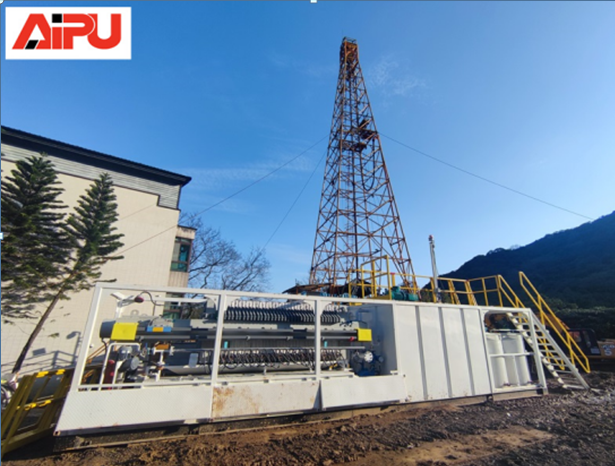Unveiling the Key Functionalities
The solids control system is a critical component in the oil and gas drilling process, playing a pivotal role in ensuring the precision of drilling fluid management. This system is designed to remove unwanted solids from the drilling fluid, maintaining its properties and performance.
Importance of Solids Control
Effective solids control is essential for several reasons. Firstly, it helps to extend the life of the drilling fluid. By removing abrasive solids, the system reduces wear and tear on drilling equipment, such as pumps and bits. This not only saves on maintenance costs but also increases the overall efficiency of the drilling operation. Secondly, proper solids control improves the quality of the drilling fluid. A clean drilling fluid can better carry cuttings to the surface, preventing blockages in the wellbore and ensuring smooth drilling progress. Moreover, it helps to maintain the stability of the wellbore, reducing the risk of wellbore collapse and other drilling problems.
Components of a Solids Control System
A typical solids control system consists of several key components. The shale shaker is the first stage of solids control. It uses vibrating screens to separate large cuttings from the drilling fluid. The desander and desilter are the next stages, which use hydrocyclones to remove finer solids. The centrifuge is a crucial component for removing ultra - fine solids. It uses centrifugal force to separate the solids from the liquid phase of the drilling fluid. Additionally, there are mud tanks, which store and circulate the drilling fluid, and various pumps and valves that control the flow of the fluid through the system.
Working Principles
The working principle of the solids control system is based on the physical separation of solids from the drilling fluid. In the shale shaker, the vibrating motion of the screens causes the large cuttings to move along the screen surface and be discharged, while the drilling fluid passes through the screens. In the hydrocyclones of the desander and desilter, the high - speed rotation of the fluid creates a centrifugal force that throws the solids towards the outer wall of the cyclone and then out through the underflow. The centrifuge operates on a similar principle but at a much higher speed, enabling it to separate even the finest solids.
Advanced Technologies in Solids Control
With the development of technology, there have been many advancements in solids control systems. For example, some modern shale shakers are equipped with variable - frequency drives, which allow for more precise control of the vibration amplitude and frequency. This can improve the screening efficiency and adapt to different types of drilling fluids and cuttings. In addition, advanced sensors and monitoring systems are being used to continuously monitor the properties of the drilling fluid and the performance of the solids control equipment. This real - time data can be used to optimize the operation of the system, ensuring maximum efficiency and precision in drilling fluid management.

Importance of Solids Control
Effective solids control is essential for several reasons. Firstly, it helps to extend the life of the drilling fluid. By removing abrasive solids, the system reduces wear and tear on drilling equipment, such as pumps and bits. This not only saves on maintenance costs but also increases the overall efficiency of the drilling operation. Secondly, proper solids control improves the quality of the drilling fluid. A clean drilling fluid can better carry cuttings to the surface, preventing blockages in the wellbore and ensuring smooth drilling progress. Moreover, it helps to maintain the stability of the wellbore, reducing the risk of wellbore collapse and other drilling problems.
Components of a Solids Control System
A typical solids control system consists of several key components. The shale shaker is the first stage of solids control. It uses vibrating screens to separate large cuttings from the drilling fluid. The desander and desilter are the next stages, which use hydrocyclones to remove finer solids. The centrifuge is a crucial component for removing ultra - fine solids. It uses centrifugal force to separate the solids from the liquid phase of the drilling fluid. Additionally, there are mud tanks, which store and circulate the drilling fluid, and various pumps and valves that control the flow of the fluid through the system.
Working Principles
The working principle of the solids control system is based on the physical separation of solids from the drilling fluid. In the shale shaker, the vibrating motion of the screens causes the large cuttings to move along the screen surface and be discharged, while the drilling fluid passes through the screens. In the hydrocyclones of the desander and desilter, the high - speed rotation of the fluid creates a centrifugal force that throws the solids towards the outer wall of the cyclone and then out through the underflow. The centrifuge operates on a similar principle but at a much higher speed, enabling it to separate even the finest solids.
Advanced Technologies in Solids Control
With the development of technology, there have been many advancements in solids control systems. For example, some modern shale shakers are equipped with variable - frequency drives, which allow for more precise control of the vibration amplitude and frequency. This can improve the screening efficiency and adapt to different types of drilling fluids and cuttings. In addition, advanced sensors and monitoring systems are being used to continuously monitor the properties of the drilling fluid and the performance of the solids control equipment. This real - time data can be used to optimize the operation of the system, ensuring maximum efficiency and precision in drilling fluid management.








